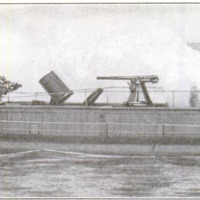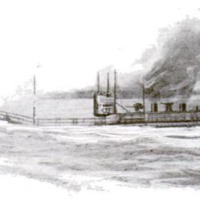The K-22, a new British steam-driven submarine
Item
-
Title (Dublin Core)
-
The K-22, a new British steam-driven submarine
-
Article Title and/or Image Caption (Dublin Core)
-
Speeding Up the Submarine with Steam
-
extracted text (Extract Text)
-
WITH smoke pouring from her
after-deck and a general topsy-
turvy look about her superstructure,
the vessel in the accompa-
nying photographs might
be thought to be getting
Hho orp of a lively bat
tle. On the contrary, she A
has never smelled an ene-
my's powder. She is a
new British type of steam-
driven submarine, and the
apparent confusion is the
result of the order: “Lower
stacks and prepare to submerge!”
Not only is the K-22 steam-driven,
but she is a giant among her kind,
being as large as earlier types of light
surface cruisers. She is 340 feet long,
and displaces nearly 3,000 tons when
in driving trim. Her great superiority
over the non-steam types is in her
surface speed, which is reported to be
twenty-four knots. Once under water,
she must rely on storage batteries for
her power, the same as any other sub-
marine, and her speed drops to ten
knots.
Steam-driven submarines have been
the dream of all navies. They have
undisputed advantages on the surface.
Naval constructors have never been
satisfied with the Diesel oil-engine. It
is heavy and complicated. The prob-
lem has been to overcome the dis-
advantages of steam when diving and
in under-water cruising. One of the
things sought has been to insulate the
boilers so well that they would keep up
steam for a long time after the fires
were put out, as they must be when
the vessel dives.
So, when the pictures of the K-22
were released by the Brit
ish censor, the first ques-
| tion was: “Has England |
solved the mystery?” |
Porurar Science MoNTaLY |
put the question to the |
United States Bureau of
Steam Engineering. The
Bureau reported that sev-
eral years ago our own
navy experimented with a
steam-driven submarine. |
pl Like the British boats, it |
had oil-fired boilers and
turbine engines, and on the surface
developed the remarkable speed—for
a submarine—of twenty-five knots. |
But the disadvantages were such that |
the type was abandoned.
To be able to get under water
quickly is a life-and-death matter with
a submarine. It was found that the
steamers lost precious seconds in stow-
ing their smokestacks, which fit into |
recesses in the decks. The fires had |
to be put out as the craft took the
plunge—otherwise the heat would be-
come unsupportable; and when she |
came to the surface after a prolonged
under-water stay, it took a compara- |
tively long time to get up steam again.
-
Language (Dublin Core)
-
eng
-
Date Issued (Dublin Core)
-
1919-06
-
pages (Bibliographic Ontology)
-
58
-
Rights (Dublin Core)
-
Public domain (Google digitized)
-
Archived by (Dublin Core)
-
Davide Donà
-
Marco Bortolami (editor)
 Popular Science Monthly, v. 94, n. 6, 1919
Popular Science Monthly, v. 94, n. 6, 1919




